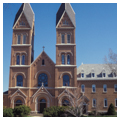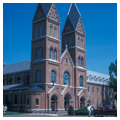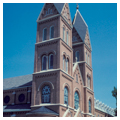Assumption Abbey’s community of Benedictine monks was founded by Father Vincent Wehrle. Immediately after his ordination in Switzerland in 1882, he volunteered for missionary work in America. In 1899, Wehrle and a handful of monks began monastic life at St. Mary’s Priory at Richardton, ministering to the growing communities of German Russian immigrants. Because there were no priests in the areas being settled in the late nineteenth century by Germans from Russia, John Shanley, the first Catholic bishop in Dakota Territory, was concerned that homesteading immigrants would lose their faith. Thus, in 1903 the Richardton monastic community was raised to the rank of an abbey, with Wehrle serving as its abbot.
Construction of the abbey church progressed from 1906 to 1910, the product of a collaborative relationship of Wehrle and Milwaukee architect Anton Dohmen (1866–1951), an immigrant from Bavaria. The design was ambitious, with a monastic quadrangle on the scale of monasteries in southern Germany and Austria. The first buildings were constructed with bricks made in the monastery’s own kilns. Dohmen is credited with designing nineteen Catholic churches in the Dakotas, including Sts. Peter and Paul (EM4) in Strasburg, St. Joseph’s (1907) in Devils Lake, St. Joseph’s (1904) in Mandan, and St. Anthony of Padua (1921) in Hoven, South Dakota. St. Mary’s Church, like his other designs, emphasizes German Romanesque features in the towers and their roofs, corbeled brick detailing, and Latin cross plans.
Wehrle and Dohmen’s professional relationship, which lasted many years, was marked by interesting exchanges in their correspondence in which Wehrle frequently pleaded poverty in order to negotiate lower architectural fees. It is believed that Dohmen profited very little financially on his design of the Dakota churches. Dohmen typically sent one or two craftsmen, along with drawings for each phase of construction, to assist with the initial construction of each church. The craftsmen trained monks, priests, and volunteers to build the churches, and much of the volunteer labor came from farmers in the community. As Coomber and Green note in Magnificent Churches on the Prairie (1996), “Part of what makes these magnificent churches so special is that they were built by German-Russian immigrants who were living in sod houses at the time.” The abbey church and the monastic buildings are dramatic in their scale on the North Dakota landscape.











